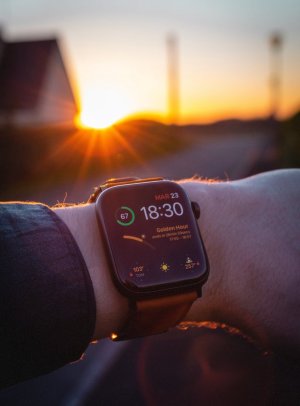Act fast! Apple’s $20 million settlement could mean cash for you—no receipt needed!
By
Veronica E.
- Replies 0
Time is running out for eligible Apple customers to claim their share of a $20 million settlement—and the best part? No receipt is required.
If you've owned certain Apple Watch models and encountered unexpected issues, you could be entitled to compensation.
Many Apple users may not even realize they qualify, making this an opportunity worth looking into.
The deadline is fast approaching, so now is the time to check if you're eligible and ensure you don't miss out on a potential payout. It only takes a few minutes to verify—don't wait until it's too late!

This settlement stems from claims that specific Apple Watch models—the first-generation, Series 1, Series 2, and Series 3—were affected by a design flaw. Customers reported that swelling batteries caused internal pressure, leading to screen cracks and other damage.
The lawsuit argued that the watches were designed without enough space to accommodate battery expansion, making them more susceptible to these issues.
While Apple has not admitted to any wrongdoing, the company has agreed to settle the claims.
As part of the resolution, eligible class members can receive cash payments for each affected device they owned or previously owned. Initial payments are set at $20 per device, though that amount may fluctuate depending on the number of claims filed.
If fewer claims are submitted, payments could increase—potentially reaching $50 per device.
Claiming your share is simple. No claim form is necessary, but eligible individuals should verify their payment details on the settlement website to ensure they receive their funds.
Unless you choose to opt out of the settlement, payments will be issued automatically.
Apple’s settlement isn’t the only opportunity for consumers to receive compensation from class action lawsuits. A separate case involving a data breach at McPherson Hospital in Kansas could result in payments of up to $5,400 for affected individuals.
Additionally, a $5.8 million settlement from Nationstar Mortgage is being distributed to resolve allegations that improper mortgage servicing led to wrongful foreclosures.
If you believe you qualify for any of these settlements, now is the time to take action. Don’t wait until it’s too late—deadlines are fast approaching, and missing them could mean losing out on money that’s rightfully yours. Don't let this opportunity slip away!

Have you experienced issues with your Apple Watch or another settlement case? We’d love to hear your thoughts—share your experiences in the comments below!
Also read: This popular Apple product could be putting you at risk for cancer – here’s what you need to know!
If you've owned certain Apple Watch models and encountered unexpected issues, you could be entitled to compensation.
Many Apple users may not even realize they qualify, making this an opportunity worth looking into.
The deadline is fast approaching, so now is the time to check if you're eligible and ensure you don't miss out on a potential payout. It only takes a few minutes to verify—don't wait until it's too late!

Apple Watch owners, if you've owned a Series 1, 2, or 3, you could be eligible for compensation. Image Source: Unsplashed / Clément Lauwaert.
This settlement stems from claims that specific Apple Watch models—the first-generation, Series 1, Series 2, and Series 3—were affected by a design flaw. Customers reported that swelling batteries caused internal pressure, leading to screen cracks and other damage.
The lawsuit argued that the watches were designed without enough space to accommodate battery expansion, making them more susceptible to these issues.
While Apple has not admitted to any wrongdoing, the company has agreed to settle the claims.
As part of the resolution, eligible class members can receive cash payments for each affected device they owned or previously owned. Initial payments are set at $20 per device, though that amount may fluctuate depending on the number of claims filed.
If fewer claims are submitted, payments could increase—potentially reaching $50 per device.
Claiming your share is simple. No claim form is necessary, but eligible individuals should verify their payment details on the settlement website to ensure they receive their funds.
Unless you choose to opt out of the settlement, payments will be issued automatically.
Apple’s settlement isn’t the only opportunity for consumers to receive compensation from class action lawsuits. A separate case involving a data breach at McPherson Hospital in Kansas could result in payments of up to $5,400 for affected individuals.
Additionally, a $5.8 million settlement from Nationstar Mortgage is being distributed to resolve allegations that improper mortgage servicing led to wrongful foreclosures.
If you believe you qualify for any of these settlements, now is the time to take action. Don’t wait until it’s too late—deadlines are fast approaching, and missing them could mean losing out on money that’s rightfully yours. Don't let this opportunity slip away!
Key Takeaways
- Apple has agreed to a $20 million settlement over claims that certain models of the Apple Watch are defective due to battery swelling issues.
- Affected consumers in the United States, who reported the problem between April 24, 2015 and February 6, 2024, are eligible for the settlement payment without needing a receipt.
- Eligible claimants can receive $20 or more per covered device, depending on the final amount available in the settlement fund.
- No claim form is required to benefit from the settlement, but class members should confirm their payment details on the settlement website to ensure they receive their payment.
Have you experienced issues with your Apple Watch or another settlement case? We’d love to hear your thoughts—share your experiences in the comments below!
Also read: This popular Apple product could be putting you at risk for cancer – here’s what you need to know!






